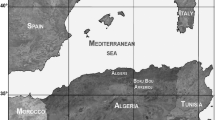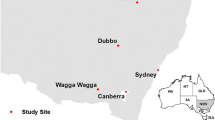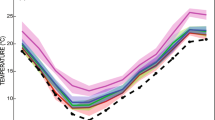Abstract
The potential effect of climate change on durum wheat in Tunisia is assessed using a simple crop simulation model and a climate projection for the 2071–2100 period, obtained from the Météo-France ARPEGE-Climate atmospheric model run under the IPCC (International Panel on Climate Change) scenario A1B. In the process-oriented crop model, phenology is estimated through thermal time. Water balance is calculated on a daily basis by means of a simple modelling of actual evapotranspiration involving reference evapotranspiration, crop coefficients and some basic soil characteristics. The impact of crop water deficit on yield is accounted for through the linear crop-water production function developed by the FAO (Food and Agriculture Organization of the United Nations). Two stations are chosen to study the climate change effect. They are representative of the main areas where cereals are grown in Tunisia: Jendouba in the northern region and Kairouan in the central region. In the future scenario, temperature systematically increases, whereas precipitation increases or decreases depending on the location and the period of the year. Mean annual precipitation declines in Jendouba and raises in Kairouan. Under climate change, the water conditions needed for sowing occur earlier and cycle lengths are reduced in both locations. Crop water deficit and the corresponding deficit in crop yield happen to be slightly lower in Kairouan; conversely, they become higher in Jendouba.
Similar content being viewed by others
References
Abou Hadid AF (2006) Final report to assessment of impacts, adaptation, and vulnerability to climate change in North Africa: food production and water resources. AIACC project no. AF90, published by the international START secretariat. http://www.aiaccproject.org/Final%20Reports/Final%20Reports/FinalRept_AIACC_AF90.pdf
Allen RG, Pereira LS, Raes D, Smith M (1998) Crop evapotranspiration: guidelines for computing crop water requirements. FAO Irrigation and drainage paper 56
Aubry C, Besse T, Chehida-Ghana A, Elloumi M, Gara M, Lamarche K, Latiri-Souki K, Sebillotte M, Soler LG (1991) Céréalicultures et dynamiques des systèmes agraires en Tunisie. Ann Inst Natl Rech Agron Tunis (numéro spécial) 64:189–236
Barbery J, Mohdi M (1983) Carte des Ressources en Sols de la Tunisie. Feuille de Kairouan. Direction des Sols, ES-202, 49 pages+cartes
Baron C, Sultan B, Balme M, Sarr B, Traore S, Lebel T, Janicot S, Dingkuhn M (2005) From GCM grid cell to agricultural plot: scale issues affecting modelling of climate impact. Philos Trans R Soc B. 360:2095–2108. doi:10.1098/rstb.2005.1741
Ben-Salem H, Zaibet L, Ben-Hammouda M (2006) Perspectives de l’adoption du semis direct en Tunisie. Une approche économique. Options Méditerr Sér A 69:69–75
Benzarti Z (1996) La maîtrise des eaux de surface: l’expérience des lacs collinaires en Tunisie. La Revue des Géographes Tunisiens, vol 4. Faculté des Sciences Humaines et Sociales de Tunis. Groupe de Recherche sur la Variabilité du Climat et l’Homme en Tunisie (GREVACHOT), pp 15
Blum A (1996) Crop responses to drought and the interpretation of adaptation. Plant Growth Regul 20:135–148
Brisson N, Gary C, Justes E, Roche R, Mary B, Ripoche D, Zimmer D, Sierra D, Bertuzzi P, Burger P, Bussière F, Cabidoche YM, Cellier P, Debaeke P, Gaudillère JP, Hénault C, Maraux F, Seguin B, Sinoquet H (2003) An overview of the crop model STICS. Eur J Agron 18:309–332
Caballero Y, Voirin-Morel S, Habets F, Noilhan J, LeMoigne P, Lehenaff A, Boone A (2007) Hydrological sensitivity of the Adour-Garonne river basin to climate change. Water Resour Res 43:W07448
Deghais M, Kouki M, Salah El Gharb M, El Felah M (2007) Les variétés de céréales en Tunisie. République Tunisienne, Ministère de l’Agriculture et des Ressources Hydrauliques, 445 p
Delécolle R, Ruget F, Ripoche D (1995) Possible effects of climate change on wheat and maize crops in France. In: Rosenzweig C, Ritchie JT, Jones JW (eds) Climate change and agriculture: analysis of potential international impact. ASA special publication 59, Madison
Déqué M (2007) Frequency of precipitation and temperature extremes over France in an anthropogenic scenario: model results and statistical correction according to observed values. Glob Planet Change 57:16–26
Doorenbos J, Kassam A (1979) Yield response to water. FAO irrigation and drainage paper 33
Gibelin AL, Déqué M (2003) Anthropogenic climate change over the Mediterranean region simulated by a global variable resolution model. Clim Dyn 20:327–339
Hénia L (1993) Climat et bilan de l’eau en Tunisie. In: Essai de régionalisation climatique par les bilans hydriques, vol XXVI. Faculté des Sciences Humaines et Sociales de Tunis, Publications de l’Université de Tunis I, Deuxième série Géographie, 266 p
Henia L, Mougou R (1998) Contribution à l’étude des phénomènes à risques en Tunisie. Cas de la gelée au sol. Les Publications de l’Association Internationale de Climatologie 8:207–215
Huard F (2007) Aspects méthodologiques de l’utilisation des scénarios de changement climatique. Note technique no. 2, INRA-Agroclim. Avignon, France
Ines AVM, Hansen JW (2006) Bias correction of daily GCM rainfall for crop simulation studies. Agric For Meteorol 138:44–53
INRAT (Institut National de la Recherche Agronomique de Tunisie) (1998) Rapport d’Activités 1998. Ministère de l’Agriculture et des Ressources Hydrauliques, Tunisie, 180 pp
IPCC (2001) Climate change 2001. The scientific basis. In: Houghton JT, Ding Y, Griggs DJ, Noguer M, Van der Linder PJ, Xiaosu D (eds) Contribution of working group I to the third assessment report of the IPCC. Cambridge University Press, UK
Latiri-Souki K, Aubry C (1991) Les céréales dans le semi-aride: potentialités, variation et contraintes. Ann Inst Natl Rech Agron Tunis (numéro spécial) 64:189–236
Latiri-Souki K, Nortcliff S, Lawlor DW (1998) Nitrogen fertilizer can increase dry matter, grain production and radiation and water use efficiencies for durum wheat under semi-arid conditions. Eur J Agron 9:21–34
Lhomme JP, Katerji N (1991) A simple modelling of crop water balance for agrometeorological applications. Ecol Model 57:11–25
Long SP, Ainsworth EA, Leakey ADB, Nosberger J, Ort DR (2006) Food and thought: lower-than-expected crop yield simulation with rising CO2 concentrations. Science 312:1918–1921
Louati MH, Khanfir R, Alouini A, El Echi ML, Frigui L, Marzouk A (1999) Guide pratique de la gestion de la sécheresse en Tunisie. In: Approche méthodologique. Publication du Ministère de l’Agriculture, Tunis
Louhichi B (1979) Etude de la durée d’insolation et du rayonnement global. Recherche de relations entre les deux paramètres. Mémoire de fin d’étude de l’Ecole de l’Aviation et de la Météorologie, Borg El Amri, Tunisie, 75 p
Luo Q, Williams MAJ, Bellotti W, Bryan B (2003) Quantitative and visual assessment of climate change impacts on South Australian wheat production. Agric Syst 77:173–186
Luo Q, Bellotti W, Williams M, Bryan B (2005) Potential impact of climate change on wheat yield in South Australia. Agric For Meteorol 132:273–285
Monteith JL (1977) Climate and the efficiency of crop production in Britain. Philos Trans R Soc Lond Ser B 281:277–294
Mougou R, Abou-Hadid A, Iglesias A, Medany M, Nafti A, Chetali R, Mansour M, Eid H (2008) Adapting dryland and irrigated cereal farming to climate change in Tunisia and Egypt. In: Leary N, Adejuwon J, Barros V, Burton I, Kulkarni J, Lasco R (eds) Climate change and adaptation book, Earthscan, UK. http://www.nhbs.com/title.php?bkfno=170111&ad_id=185
Raes D, Geerts S, Kipkorir E, Wellens J, Sahli A (2006) Simulation of yield decline as a result of water stress with a robust soil water balance model. Agric Water Manag 81:335–357
Reyenga PJ, Howden SM, Meinke H, McKeon GM (1999) Modelling global change impacts on wheat cropping in southeast Queensland, Australia. Environ Model Softw 14:297–306
Rosenzweig C, Hillel D (1998) Climate change and the global harvest: potential impacts of the greenhouse effects on agriculture. Oxford University Press, USA
Sakiss N, Ennabli N, Slimani MS (1991) La pluviométrie en Tunisie. Institut National Agronomique de Tunisie et Institut National de la Météorologie, Tunis, 123 p
Souissi A, Ghezal F (1971) Etude pédologique des plaines des oueds Bou Herthma, Tessa et Mellègue. Division des sols, Ministère de l’Agriculture et des Ressources Hydrauliques, Tunis 150 pages+cartes
Stockle C, Donatelli M, Nelson R (2003) CropSyst, a cropping systems simulation model. Eur J Agron 18:289–307
Teixeira JL, Fernado RM, Pereira LS (1995) Irrigation scheduling alternative for limited water supply and drought. ICID J 44:73–87
Tubiello FN, Ewert F (2002) Simulating the effects of elevated CO2 on crops: approaches and applications for climate change. Eur J Agron 18:57–74
Tubiello FN, Amthor JS, Boote KJ, Donatelli M, Easterling W, Fischer G, Gifford RM, Howden M, Reilly J, Rosenzweig C (2007) Crop response to elevated CO2 and world food supply. A comment on “Food and thought...” by Long et al., Science 312: 1918–1921, 2006. Eur J Agron 26:215–223
Zairi A, El Amami H, Slatni A, Pereira LS, Rodriguez PN, Machado T (2003) Coping with drought: deficit irrigation strategies for cereals and field horticultural crops in central Tunisia. In: Rossi G, Cancelliere A, Pereira LS, Oweis T, Shatanawi M, Zairi A (eds) Tools for drought mitigation in Mediterranean regions. Water Science and Technology Library. Kluwer Academic Pub
Author information
Authors and Affiliations
Corresponding author
Rights and permissions
About this article
Cite this article
Lhomme, J.P., Mougou, R. & Mansour, M. Potential impact of climate change on durum wheat cropping in Tunisia. Climatic Change 96, 549–564 (2009). https://doi.org/10.1007/s10584-009-9571-9
Received:
Accepted:
Published:
Issue Date:
DOI: https://doi.org/10.1007/s10584-009-9571-9




